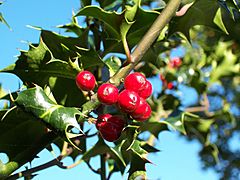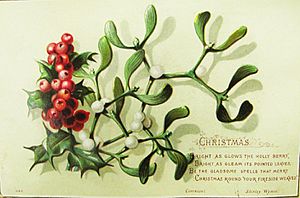Holly facts for kids
Quick facts for kids Holly |
|
|---|---|
 |
|
| European Holly (Ilex aquifolium) leaves and fruit | |
| Scientific classification | |
| Kingdom: | |
| Division: | |
| Class: | |
| Subclass: | |
| (unranked): | |
| Order: |
Aquifoliales
|
| Family: |
Aquifoliaceae
DC. ex A.Rich.
|
| Genus: |
Ilex
|
| Species | |
|
About 600, see text |
|
Holly is a type of bush or small tree. It has easily recognized leaves with sharp, spiny edges. Holly is often used to decorate homes, especially around Christmas. Some types of holly are even used to make tea. Holly leaves stay green all winter. This is because they are very thick and have a waxy layer. This layer helps them keep water and not freeze.
Contents
What Does Holly Look Like?
Holly plants grow all over the world. You can find them in places with mild weather, called temperate areas. They also grow in warmer, subtropical regions. The Ilex group includes trees, bushes, and climbing plants. Some hollies keep their leaves all year (evergreen). Others lose their leaves in the fall (deciduous).
Holly plants usually grow slowly. Some can reach up to 25 meters (about 82 feet) tall. The most famous type is the European holly, Ilex aquifolium. This plant was first described by a scientist named Linnaeus.
Holly leaves are usually shiny and smooth. They often have spiny edges. The flowers are small and greenish-white. They have four petals. Most holly plants are dioecious. This means that male flowers and female flowers grow on different plants. For a holly plant to produce berries, you usually need both a male and a female plant nearby.
Holly Berries
The small fruits of holly are often called berries. But they are actually a type of fruit called a drupe. Drupes have a hard pit or "stone" inside, like a peach. Holly berries can be red, brown, black, or sometimes green or yellow. Each "stone" inside the berry can hold up to ten seeds.
These berries ripen in winter. Their bright red color against the green leaves looks very festive. This is why cut holly branches are popular for Christmas decorations.
Are Holly Berries Safe to Eat?
Holly berries are generally a little toxic to humans. If someone eats them, they can cause vomiting and diarrhea. It's especially important to keep young children away from the bright red berries. Eating more than 20 berries could be very dangerous for a child.
Holly leaves, if eaten, can also cause stomach problems. This includes diarrhea, nausea, and vomiting. Holly plants can also be toxic to pets and farm animals.
Even though they are toxic to humans, holly berries are an important food for birds and other animals. These animals help spread the holly seeds to new places.
Where Does Holly Grow?
Holly plants are found in many different climates around the world. Most types grow in warm tropical and subtropical areas. But they also grow in temperate zones. The largest number of different holly species are found in the Americas and Southeast Asia.
In Europe, there is only one main type of holly, the classic Ilex aquifolium. In Africa, you can find this species and Ilex mitis. Australia has its own unique holly, Ilex arnhemensis.
China has many different holly species, with 149 types found only there. One very important holly is Ilex paraguariensis. This plant is used to make a popular tea called Yerba mate in Spanish-speaking countries.
Many holly species are becoming rare. This is because they have developed to grow in specific places, like islands or small mountain ranges. Also, people often use these plants, which can put them at risk.
Holly in Nature
Holly plants are a very important food source for many types of birds. Other wild animals also eat them. In the fall and early winter, holly berries are hard and don't taste very good. But after they have been frozen or frosted a few times, they become softer and milder.
During winter storms, birds often hide in holly bushes. The spiny leaves offer shelter and protection from predators. The berries also provide food when other sources are scarce. Some insects, like the double-striped pug moth, eat holly flowers. Other moths, like Bucculatrix ilecella, feed only on holly plants.
How People Use Holly
People in some cultures use the leaves of certain holly species to make daily tea. Famous examples include:
- Yerba mate (from I. paraguariensis)
- Ilex guayusa
- Kuding (from Ilex kaushue)
- Yaupon (from I. vomitoria)
Other types of holly, like gallberry (I. glabra), have bitter leaves. Not much is known about how the chemicals in different holly species vary.
Holly in Culture

Holly, especially the European holly (Ilex aquifolium), is a very common symbol at Christmas time. It is sometimes called Christ's thorn. In many Western Christian countries, holly is a traditional Christmas decoration. It is often used in wreaths and on Christmas cards.
Images for kids
See also
 In Spanish: Acebos para niños
In Spanish: Acebos para niños











